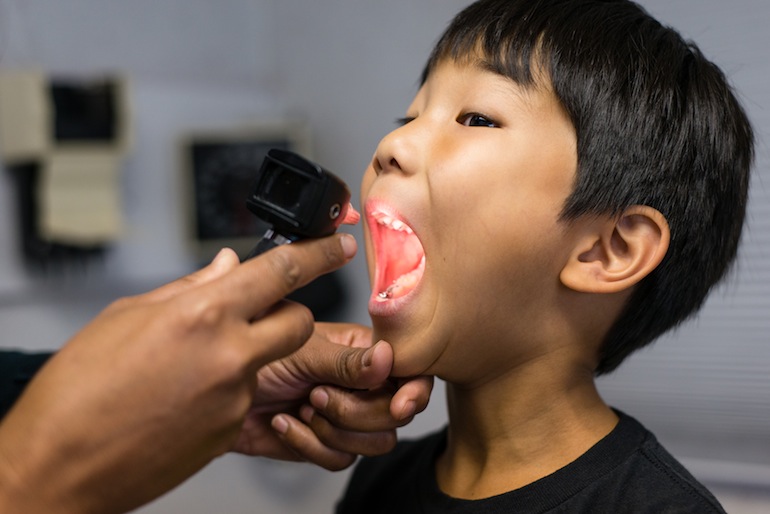
Scarlett Negrete, 3, learns how to use her inhaler during her appointment at the Children’s Hospital of Orange County Breathmobile on April 17, 2015. Negrete has missed 10 days of school this year due to her asthma (Photo by Heidi de Marco/KHN).
Children in California increasingly are flocking to emergency rooms for treatment of asthma, despite millions of dollars spent on programs to control the disease.
Statewide, the rates of ER visits for asthma symptoms rose by about 18 percent for California children ages 5 to 17 and by 6 percent for children under 5 between 2005 and 2012, according to a Kaiser Health News analysis of the latest available rates by county.
In some parts of the state, especially the Central Valley, the increases were far higher. The rate of emergency room visits for children 5 and older more than doubled in rural Madera County and nearly doubled In Merced. In Sacramento County, they rose by 48 percent and in Los Angeles, the largest county in the nation, by 17 percent.
All told, more than 72,000 California children under 18 visited the ER for asthma in 2012.

The Children’s Hospital of Orange County Breathmobile, parked at Sycamore Junior High in Anaheim, California, serves the low-income communities in the area (Photo by Heidi de Marco/KHN).
“There’s clearly more work to be done if this many kids are going to the emergency department,” said Anne Kelsey Lamb, director of the Regional Asthma Management and Prevention program of the Oakland-based Public Health Institute. “We know a lot about what works. We absolutely should be able to reduce the rates we’re seeing.”
At the national level, asthma-related emergency room visit rates have declined in recent years, according to federal health data through 2010, the latest available.
Although ER visits declined in some counties, including Alameda, San Mateo and Marin, the overall rise in California has frustrated public health experts who have spent millions of dollars and countless hours to improve and expand asthma prevention programs around the state. The state and federal governments alone spend $1.54 million annually on such projects in California, including grants to schools to improve indoor air quality and training community health workers.
 The good news is fewer kids are actually being admitted into hospitals. Overnight-or-longer stays are declining statewide and nationally. That’s due largely to better medicines and more aggressive treatment in the ER, asthma specialists say.
The good news is fewer kids are actually being admitted into hospitals. Overnight-or-longer stays are declining statewide and nationally. That’s due largely to better medicines and more aggressive treatment in the ER, asthma specialists say.
The reasons for the increase in ER visits are complex, experts say. They include parents not properly administering medications, poverty and inadequate insurance coverage, persistently high levels of indoor and outdoor pollution in some regions and the limited reach of programs that seek to manage symptoms or prevent them.
 The rising rates don’t seem to reflect an actual increase in the respiratory disease – about 15 percent of California children have been diagnosed with asthma, a number that has remained fairly steady since 2001.
The rising rates don’t seem to reflect an actual increase in the respiratory disease – about 15 percent of California children have been diagnosed with asthma, a number that has remained fairly steady since 2001.
The rates of ER visits vary widely by county, from a high of 300 visits per 10,000 children under age 5 (Madera County) to a low of 32 (Sutter County) in 2012. Younger children visit the ER at higher rates because they are more likely to have undiagnosed asthma and because their lung function is more difficult to measure, complicating the task of finding the right combination of medicines, Kelsey Lamb said.
Some families seek treatment in the ER for symptoms that easily could be dealt with in a clinic because they can’t get a timely doctor’s appointment or don’t have a regular doctor – especially those without health insurance. Sometimes, a bad cold and flu season can aggravate asthma that is usually well-controlled.
Affected children often live in homes with dust, mold or pets, which trigger asthma symptoms. They may need two inhalers – one for school and one for home – but insurance sometimes only pays for one.
In the Central Valley, persistent poverty and outdoor air pollution levels combine to produce the highest rates of ER visits for childhood asthma in the state.
While particulate matter and ozone air pollution levels are declining somewhat in the region, they still can be high enough to trigger asthma attacks, said John Capitman, a California State University-Fresno public health professor and executive director of the Central Valley Health Policy Institute. In Los Angeles, the same holds true, although particulates are slightly lower than in parts of in the Central Valley.
Across California, local and regional asthma programs aim to educate families and doctors to help keep kids out of the hospital. In counties including Orange and Los Angeles, medically equipped vans called “Breathmobiles” provide comprehensive care in community settings and ensure children don’t end up repeatedly in the ER.


It worked for Daniel Lee, 5, of Buena Park, who was still experiencing severe asthma symptoms after five trips to the ER last year. It turned out the doctors at the hospital had mixed his medications incorrectly — a common mistake when kids are treated in emergency rooms rather than by asthma-trained pediatricians, said Dr. Olga Guijon, associate medical director of the Breathmobile for Children’s Hospital of Orange County.
“All he wants to do is play soccer,” said his mother Young Lee, during a recent visit to the Breathmobile in Anaheim. “But every time he’s running around on the field, he says: ‘I feel weird’. So he has to stop.”
Daniel has improved drastically after being treated at the Breathmobile and having his medication adjusted, his mother said.
Though often effective, these programs are expensive and can’t serve enough children to make a real difference statewide, Capitman said. And health outreach workers have found it difficult to get reimbursed by insurers, including Medi-Cal, for proven strategies including home visits to minimize risks, Capitman said.
Dr. Amy Harrison, a pediatric pulmonologist at Children’s Hospital Orange County, suggested that the recession had driven some families to her hospital’s ER, because they had lost their insurance or had high-deductible insurance that led them to forgo prescriptions and regular doctor visits.
Because the data don’t extend beyond 2012, it remains unclear how expanded coverage offered since last year under the Affordable Care Act and California’s Medicaid program will affect emergency room visits. But experts like Capitman hope to see more funding for programs that manage or prevent asthma symptoms through the Affordable Care Act’s Prevention and Public Health Fund.

Olga Guijon, associate medical director of CHOC’s Breathmobile, explains what Brooke Kessler can do to asthma proof her home for her daughter Scarlett Negrete (Photo by Heidi de Marco/KHN).
Asthma care for kids has improved markedly in recent years, in part because of the wider use of steroid inhalers. Influential asthma management guidelines released in 2007 also have helped.
But some families simply don’t know how to manage their child’s condition at home, or know when to seek medical care before an ER visit becomes necessary, said Dr. Rami Keisari, medical director of the Pediatric Asthma Disease Management Program at the county-run Santa Clara Valley Medical Center in San Jose.
“One of the biggest challenges we have is getting parents to use the medications every day,” Keisari said. “We have a really hard time convincing parents that this is a chronic condition.”
Some of the few large counties with declining ER visits have invested heavily in targeting kids who are at risk. Alameda County children who have been treated in ERs are referred to the county’s free Asthma Start program, which offers free home visits during which health workers identify asthma triggers, offer education and provide equipment such as spacers and nebulizers – even vacuum cleaners, said program director Brenda Yamashita of the Alameda County Department of Public Health.
Parents learn to freeze stuffed animals to kill asthma-triggering dust mites, track their children’s symptoms on a calendar, and clean surfaces without bleach, which can aggravate symptoms. Alameda Alliance for Health, the county’s public, nonprofit health insurance plan, reimburses Yamashita’s program for home visits.
For parents in substandard rental housing, staffers call on the county’s Healthy Homes department to press landlords to get rid of vermin, fix leaks and address other code violations.
In Santa Clara County, Keisari’s staff keeps tabs on kids for as long as three years. Every month, a public health nurse calls parents and ask about their children’s symptoms and medications.
The county’s overall child ER visit rates are low compared to other counties. Even so, the number of children the program serves is limited compared to the need. And while the county’s asthma ER visit rates declined by 21 percent for children under 5, they rose 12 percent for children aged 5 to 17.
“We’re doing better with all these programs, but is it adequate? No. Every time a kid winds up in the ER with bad exacerbation of asthma, it’s a failure,” said Stanford University child health policy researcher Dr. Paul Wise.
Heidi de Marco contributed reporting.







